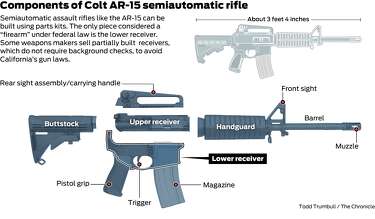Column 1: The serial number itself (including prefix). Column 2: The beginning serial number in that book. Column 3: The beginning date for that book. If there is only one date listed after the serial numbers in column 2 and/or 2, all of those numbers were manufactured on that same day. Column 4: End date for that book. Bushmaster Serial Number Lookup Bfi Remington President C.K. Davis (1933 to 1953), L. Ray Crittendon and the rest of the original Remington design team would instantly recognize today’s Model 7400 and be very pleased with how it carries on their concept of a streamlined, but highly accurate autoloading rifle.

Introduced in 1955, over 2.5 million gas operated Remington A Du Pont executive, Charles Krum Davis, took over Serious work on a completely new autoloading | aluminum alloy receiver large enough to accommodate the .300 H&H Magnum. By 1947 there were two gun design teams working on In the late 1940s, three gas operating systems, tappet The Model 742 engineering studies designation was |
Remington 700 Serial Question : Guns
| Page 14 | 4th Quarter 2009 |
| Page 15 | 4th Quarter 2009 |
| Page 16 | 4th Quarter 2009 |
The new Model 740’s introduction, originally scheduled for the
The first production Model 740, serial number 1001, “F” grade May 1956 saw the introduction of the caliber .308 Winchester. The .244 Remington was added to the list of calibers in 1957. | 35 D & F grade engraved rifles. Around 1,000 caliber .244 Remington Model 740s remained in the warehouse and sales, in this caliber, continued through 1961 to clear the inventory. The Model 742 began as a Model 740 |
Bushmaster Serial Number
| Page 17 | 4th Quarter 2009 |
The new Model 742, in two grades and three calibers .30-06, .308 The Model 742 carbine, with a 18 ½ inch barrel and 7 ¼ pound The single Standard grade stock with pressed checkering replaced The Model 742 serial number sequence was changed on November |

| Page 18 | 4th Quarter 2009 |
The Remington Model 742 was The total production of the
| In 1974 Remington began a major product improvement program to replace The major improvements over the Model 742 were a simpler bolt, which now |

| Page 19 | 4th Quarter 2009 |
| Page 20 | 4th Quarter 2009 |
The Remington Model Four was introduced January | The following list is of Remington Model Four
Two unique promotional tie-ins were introduced in the |
The Sportsman 74 rifle, a lower cost version of the Model 7400, was introduced in mid- |
The popular priced Model 7400, introduced in 1981 The first major change in the Model 7400 came in 1991 | pattern of cut checkering. The wood finish remained satin; however, rifles, in calibers .30-06 and .270 Winchester, were available with a gloss wood finish. The overall length of both the rifle and the carbine increased by 5/8 of an inch to 42 5/8 inches and 39 ½ inches respectively. The Model 7400 SP or Special Purpose was introduced Receiver panels of the Model 7400 were embellished |
| Page 21 | 4th Quarter 2009 |

A synthetic-stocked Model 7400 was introduced in 1998 and, as of 2009, remains part of the firearms line. The fiberglass-reinforced buttstock and forearm as well as the metal work have a matte black non-reflective finish. It is offered both as a rifle and as a carbine in the same calibers as the wood-stocked models. Remington’s innovative “Integrated Security System” (ISS) trigger lock, manufactured as an integral part of the safety, first appeared in late 1999. The Model 7400 “Weathermaster” was introduced in 2002. It featured a black synthetic stock with a matte nickel plated receiver, barrel, and magazine for protection against inclement conditions. This item remains in current 2009 inventory. |
The 1990s began the era of niche marketing as Several roll-engraved commemorative Model 742s and | Remington celebrated the Bicentennial by offering |
| Page 22 | 4th Quarter 2009 |
Fewer than thirty five gun sets, consisting of a Model 700 |
bolt action Model 870 pump shotgun, Model 1100 autoloaded shotgun,
Model 7400 autolader rifle and the Model 7600 rifle, were sold in 1996 to
commemorate the 180th Anniversary or Remington. The Model 7400 left receiver panel had a pair of rams, a bust of Eliphalet Remington and a 180th Anniversary banner, all gold embellished. The right receiver panel had two gold embellished elk. The 1997 catalog offered the Buckmasters Limited Edition M7400 with special pressure applied fine-line engraving on both receiver panels and fewer than 800 were sold.
Remington President C.K. Davis (1933 to 1953) , L. Ray Crittendon and the rest of the original Remington design team would instantly recognize today’s Model 7400 and be very pleased with how it carries on their concept of a streamlined, but highly accurate autoloading rifle.
| Page 23 | 4th Quarter 2009 |
| On-line Search/Sort Journal Index | On-line Journal Articles New Journals have links to
|